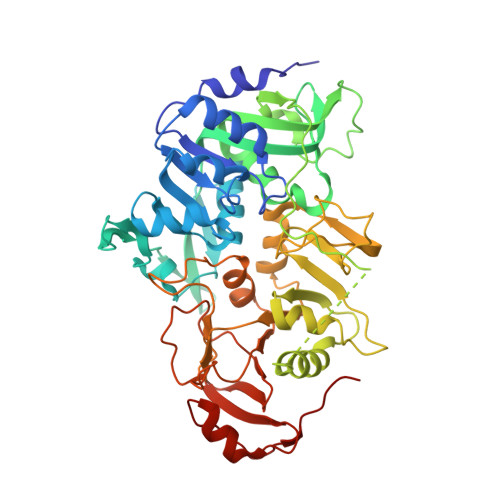The ASCT/SCS cycle fuels mitochondrial ATP and acetate production in Trypanosoma brucei.
Mochizuki, K., Inaoka, D.K., Mazet, M., Shiba, T., Fukuda, K., Kurasawa, H., Millerioux, Y., Boshart, M., Balogun, E.O., Harada, S., Hirayama, K., Bringaud, F., Kita, K.(2020) Biochim Biophys Acta Bioenerg 1861: 148283-148283
- PubMed: 32763239
- DOI: https://doi.org/10.1016/j.bbabio.2020.148283
- Primary Citation of Related Structures:
6LP1 - PubMed Abstract:
Acetate:succinate CoA transferase (ASCT) is a mitochondrial enzyme that catalyzes the production of acetate and succinyl-CoA, which is coupled to ATP production with succinyl-CoA synthetase (SCS) in a process called the ASCT/SCS cycle. This cycle has been studied in Trypanosoma brucei (T. brucei), a pathogen of African sleeping sickness, and is involved in (i) ATP and (ii) acetate production and proceeds independent of oxygen and an electrochemical gradient. Interestingly, knockout of ASCT in procyclic form (PCF) of T. brucei cause oligomycin A-hypersensitivity phenotype indicating that ASCT/SCS cycle complements the deficiency of ATP synthase activity. In bloodstream form (BSF) of T. brucei, ATP synthase works in reverse to maintain the electrochemical gradient by hydrolyzing ATP. However, no information has been available on the source of ATP, although ASCT/SCS cycle could be a potential candidate. Regarding mitochondrial acetate production, which is essential for fatty acid biosynthesis and growth of T. brucei, ASCT or acetyl-CoA hydrolase (ACH) are known to be its source. Despite the importance of this cycle, direct evidence of its function is lacking, and there are no comprehensive biochemical or structural biology studies reported so far. Here, we show that in vitro-reconstituted ASCT/SCS cycle is highly specific towards acetyl-CoA and has a higher k cat than that of yeast and bacterial ATP synthases. Our results provide the first biochemical basis for (i) rescue of ATP synthase-deficient phenotype by ASCT/SCS cycle in PCF and (ii) a potential source of ATP for the reverse reaction of ATP synthase in BSF.
Organizational Affiliation:
Department of Immunogenetics, Institute of Tropical Medicine (NEKKEN), Nagasaki University, Japan; Graduate School of Biomedical Sciences, Nagasaki University, Japan.
















